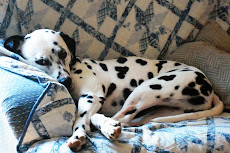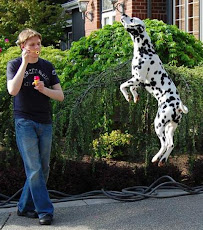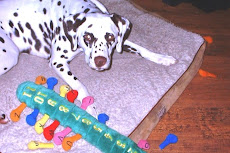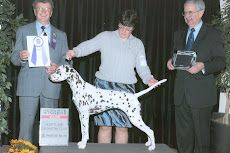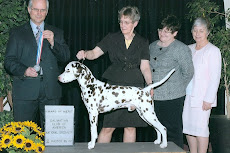Why Crufts Should Worry Us
The hair has been standing up on the back of my neck since several breeds were disqualified at Crufts last week following the introduction of the new scheme calling for veterinary checks for the Best of Breed winners.
This is a very, very slippery slope and as dog fanciers, we’re standing at the edge of it. I keep thinking of Martin Niemoller’s quote which I’ve shortened and paraphrased to save space: When the Nazis came for the communists, I remained silent because I wasn’t a communist. When they came for the trade unionists, I didn’t speak out because I wasn’t a trade unionist. When they came for the Jews,I remained silent because I wasn’t a Jew. When they came for me, there was no one left to speak out. Now substitute a breed in any of those sentences above: When they came for the American Staffordshire Terrier, I didn’t say anything because I didn’t own an Am Staff. When they came for the Peke, I didn’t say anything because I didn’t own a Peke. You see where this is going.
How long before “someone else” decides that the corded coat on my breed is excessive? One doesn’t see a Puli herding sheep in a show coat, or jogging with their owner in the summer. A Puli in a fully corded coat sinks like a rock if it falls into water. How long before “someone else” decides that my dog can’t possibly be a normal dog because of the “strain” the coat inflicts upon their heart, or because it compromises their ability to regulate their internal thermostat? How can Puli in coat possibly be comfortable?
And who should decide this? Someone like me who’s been in the breed for 30 years, or “someone else” who may never have seen a Puli in person?
I wouldn’t be too quick to dismiss that it will never happen. I never dreamt that bully breeds would be outlawed in certain cities. I never dreamt that by driving 45 minutes north of where I live, I would magically transform from “dog owner” to “dog guardian.” I never dreamt that the AKC would accept mixed breeds for any reason. I never – in my wildest imagination – ever conceived of the day when people would be “guilted” for owning a purebred dog, or that “breeder” would one day be a dirty word, or that people with placards would stand on the Best in Show platform at Westminster and inform the audience that they are all dog killers.
day be a dirty word, or that people with placards would stand on the Best in Show platform at Westminster and inform the audience that they are all dog killers.
If any of the aforementioned had happened overnight, we would have been outraged. But such things happen by inches over time and now here we are, living at a time when everything I mentioned in the paragraph above is a reality. What happened at Crufts is simply another tick in the ruler that edges us closer to the Animal Rights vision, and we’ll continue to be the chumps of the world if we can’t piece together the logical consequences of where all this is going.
Had the documentary, Pedigreed Exposed” written with an animal rights thrust not been broadcast in the UK, we wouldn’t be talking about DQs at Crufts right now. But it did air, complete with what many felt were misleading, if not inaccurate statements that caused a backlash. In the view of many, the Kennel Club failed to defend good breeders after its broadcast, and then added injury to insult by bowing to pressure from animal rights groups. This year, Crufts instituted compulsory health checks for all dogs that won Best of Breed in fifteen “high profile breeds,” and any dog failing the check was withdrawn from the remainder of the competition. For several dogs, this is exactly what happened.
The system’s “underbelly” is frought with vulnerable spots, not the least of which is that the decision of the vet who used appearance as a standard for health was as subjective as a dog show judge’s opinion. In truth, many of the biggest health threats in dogs can’t even be seen with the naked eye.
If you don’t think this can happen here, consider that on the heels of the fuss caused by “Pedigree Exposed,” the Humane Society of the United States (HSUS) convened “The Purebred Paradox” conference in 2011 which featured many of the same players who brought the issue onto center stage in Great Britain. Do you really think they’ll stop until they get results similar to what happened in England? And do you think they’ll stop there?
This is not to dismiss the fact that in some breeds, there aren’t concerns. But where there are problems with a breed, I don’t believe it’s up to people who don’t know a thing about that breed or even the fancy to dictate to rest of us how to remedy it. Who better to know what rears its ugly head in a breed than the breeders, exhibitors and owners who’ve devoted their lives to that breed? Every breed (including mixed breeds) has issues and BREEDERS are working on them. The AR bunch didn’t work to eliminate Storage Disease. Breeders did. Some might offer as a rebuttal that until Crufts, breeders weren’t policing themselves. While this point is taken, it’s akin to offering as a remedy to a broken arm an entire body cast.
Indulge me for a minute as I digress. The February, 2012 edition of National Geographic contained a cover article on Purebred dogs which I was sure was going to be another “hit piece” on pedigreed dogs. I read it reluctantly, but I did read it. The thrust of the article was that breeders in the Victorian era assumed that the vast differences of phenotypes in dogs, from the tiny Chihuahua to the grandeur of the Great Dane, also extended to their genes. As we learn more about our dogs, however, we’ve learned that in fact, few genes separate our breeds.This is a boon for people, less so for dogs. Why? As the article asserted, breeders have unwittingly supplied science with the perfect models through which to study human disease because we share many of the same diseases with dogs.
We’ve long known the untold benefits dogs have on our lives, and science studying the rich variety of breeds to cure what ails us is just one more thing dogs give us. But I interpreted the main point of the article differently. Now that breed type has been established and identified in each breed standard, allow the breeders to partner with science to eliminate issues out of their respective breeds, such as Storage Disease, while preserving breed type. But WE do it, the breeders. Not people who’ve never owned or bred a purebred dog. Not people who don’t share our love of what a purebred dog brings to the table. And certainly not Animal Rights zealots leaning on Crufts.
Guess who else benefits from the hard work that breeders do to ensure sound dogs. The mutts. It’s a fallacy that mixed breeds are sounder than purebred dogs. The incidence of disease may seem higher in purebred dogs because their owners and BREEDERS report it to their vets. Breed clubs gather annually at National Specialties to “check in” with their breeds. When was the last time the owners of mixed breeds convened to ensure the future soundness of their, um, breeds? I can’t tell you how many unsound mutts I see walking down a street, their owners oblivious to what is an obvious hip issue. But it’s the breeders and their clubs that fund research. It’s the breeders who sound the alarm if a disease shows up in their line or their breed. And in the end, it’s breeders who must solve this situation by policing our own, not the animal rights groups or even a registry like the Kennel Club.
Coming full circle, it is true that fanciers in some breeds needed to be nudged, and in that regard, there is blame to go around. As fellow fanciers, we should have been policing our own. As fanciers, we value balance in our dogs, and as a rule, it’s how we approach the world. But animal rights zealots have tipped the balance to an extreme and what happened at Crufts is a symptom of it. It’s not too late for us to take over the throttle of this runaway train and slow it down to where reasonable people can act – but we’re running out of time. In my perfect world, we’d be doing a little leaning of our own on the organizations which have portrayed themselves as our advocates by urging them to be more visible in the fight. They need to do what Crufts didn’t and stand up for the responsible purebred dog fancier.
As my children were growing up, I used to tell them that they had better learn the lessons I was teaching them because I was teaching them those lessons with love. If my kids didn’t learn, the world would teach them the same lessons but not give a whit about their feelings or self esteem. I suspect this is where we are now. While we were minding our own business, the AR bunch was sucker punching us. How long do we keep taking the hits?
This is a very, very slippery slope and as dog fanciers, we’re standing at the edge of it. I keep thinking of Martin Niemoller’s quote which I’ve shortened and paraphrased to save space: When the Nazis came for the communists, I remained silent because I wasn’t a communist. When they came for the trade unionists, I didn’t speak out because I wasn’t a trade unionist. When they came for the Jews,I remained silent because I wasn’t a Jew. When they came for me, there was no one left to speak out. Now substitute a breed in any of those sentences above: When they came for the American Staffordshire Terrier, I didn’t say anything because I didn’t own an Am Staff. When they came for the Peke, I didn’t say anything because I didn’t own a Peke. You see where this is going.
How long before “someone else” decides that the corded coat on my breed is excessive? One doesn’t see a Puli herding sheep in a show coat, or jogging with their owner in the summer. A Puli in a fully corded coat sinks like a rock if it falls into water. How long before “someone else” decides that my dog can’t possibly be a normal dog because of the “strain” the coat inflicts upon their heart, or because it compromises their ability to regulate their internal thermostat? How can Puli in coat possibly be comfortable?
And who should decide this? Someone like me who’s been in the breed for 30 years, or “someone else” who may never have seen a Puli in person?
I wouldn’t be too quick to dismiss that it will never happen. I never dreamt that bully breeds would be outlawed in certain cities. I never dreamt that by driving 45 minutes north of where I live, I would magically transform from “dog owner” to “dog guardian.” I never dreamt that the AKC would accept mixed breeds for any reason. I never – in my wildest imagination – ever conceived of the day when people would be “guilted” for owning a purebred dog, or that “breeder” would one
 day be a dirty word, or that people with placards would stand on the Best in Show platform at Westminster and inform the audience that they are all dog killers.
day be a dirty word, or that people with placards would stand on the Best in Show platform at Westminster and inform the audience that they are all dog killers.If any of the aforementioned had happened overnight, we would have been outraged. But such things happen by inches over time and now here we are, living at a time when everything I mentioned in the paragraph above is a reality. What happened at Crufts is simply another tick in the ruler that edges us closer to the Animal Rights vision, and we’ll continue to be the chumps of the world if we can’t piece together the logical consequences of where all this is going.
Had the documentary, Pedigreed Exposed” written with an animal rights thrust not been broadcast in the UK, we wouldn’t be talking about DQs at Crufts right now. But it did air, complete with what many felt were misleading, if not inaccurate statements that caused a backlash. In the view of many, the Kennel Club failed to defend good breeders after its broadcast, and then added injury to insult by bowing to pressure from animal rights groups. This year, Crufts instituted compulsory health checks for all dogs that won Best of Breed in fifteen “high profile breeds,” and any dog failing the check was withdrawn from the remainder of the competition. For several dogs, this is exactly what happened.
The system’s “underbelly” is frought with vulnerable spots, not the least of which is that the decision of the vet who used appearance as a standard for health was as subjective as a dog show judge’s opinion. In truth, many of the biggest health threats in dogs can’t even be seen with the naked eye.
If you don’t think this can happen here, consider that on the heels of the fuss caused by “Pedigree Exposed,” the Humane Society of the United States (HSUS) convened “The Purebred Paradox” conference in 2011 which featured many of the same players who brought the issue onto center stage in Great Britain. Do you really think they’ll stop until they get results similar to what happened in England? And do you think they’ll stop there?
This is not to dismiss the fact that in some breeds, there aren’t concerns. But where there are problems with a breed, I don’t believe it’s up to people who don’t know a thing about that breed or even the fancy to dictate to rest of us how to remedy it. Who better to know what rears its ugly head in a breed than the breeders, exhibitors and owners who’ve devoted their lives to that breed? Every breed (including mixed breeds) has issues and BREEDERS are working on them. The AR bunch didn’t work to eliminate Storage Disease. Breeders did. Some might offer as a rebuttal that until Crufts, breeders weren’t policing themselves. While this point is taken, it’s akin to offering as a remedy to a broken arm an entire body cast.
Indulge me for a minute as I digress. The February, 2012 edition of National Geographic contained a cover article on Purebred dogs which I was sure was going to be another “hit piece” on pedigreed dogs. I read it reluctantly, but I did read it. The thrust of the article was that breeders in the Victorian era assumed that the vast differences of phenotypes in dogs, from the tiny Chihuahua to the grandeur of the Great Dane, also extended to their genes. As we learn more about our dogs, however, we’ve learned that in fact, few genes separate our breeds.This is a boon for people, less so for dogs. Why? As the article asserted, breeders have unwittingly supplied science with the perfect models through which to study human disease because we share many of the same diseases with dogs.
We’ve long known the untold benefits dogs have on our lives, and science studying the rich variety of breeds to cure what ails us is just one more thing dogs give us. But I interpreted the main point of the article differently. Now that breed type has been established and identified in each breed standard, allow the breeders to partner with science to eliminate issues out of their respective breeds, such as Storage Disease, while preserving breed type. But WE do it, the breeders. Not people who’ve never owned or bred a purebred dog. Not people who don’t share our love of what a purebred dog brings to the table. And certainly not Animal Rights zealots leaning on Crufts.
Guess who else benefits from the hard work that breeders do to ensure sound dogs. The mutts. It’s a fallacy that mixed breeds are sounder than purebred dogs. The incidence of disease may seem higher in purebred dogs because their owners and BREEDERS report it to their vets. Breed clubs gather annually at National Specialties to “check in” with their breeds. When was the last time the owners of mixed breeds convened to ensure the future soundness of their, um, breeds? I can’t tell you how many unsound mutts I see walking down a street, their owners oblivious to what is an obvious hip issue. But it’s the breeders and their clubs that fund research. It’s the breeders who sound the alarm if a disease shows up in their line or their breed. And in the end, it’s breeders who must solve this situation by policing our own, not the animal rights groups or even a registry like the Kennel Club.
Coming full circle, it is true that fanciers in some breeds needed to be nudged, and in that regard, there is blame to go around. As fellow fanciers, we should have been policing our own. As fanciers, we value balance in our dogs, and as a rule, it’s how we approach the world. But animal rights zealots have tipped the balance to an extreme and what happened at Crufts is a symptom of it. It’s not too late for us to take over the throttle of this runaway train and slow it down to where reasonable people can act – but we’re running out of time. In my perfect world, we’d be doing a little leaning of our own on the organizations which have portrayed themselves as our advocates by urging them to be more visible in the fight. They need to do what Crufts didn’t and stand up for the responsible purebred dog fancier.
As my children were growing up, I used to tell them that they had better learn the lessons I was teaching them because I was teaching them those lessons with love. If my kids didn’t learn, the world would teach them the same lessons but not give a whit about their feelings or self esteem. I suspect this is where we are now. While we were minding our own business, the AR bunch was sucker punching us. How long do we keep taking the hits?




.jpg)
.jpg)
.jpg)









